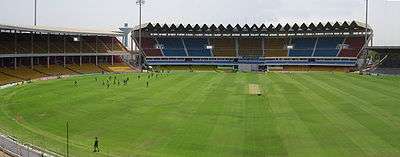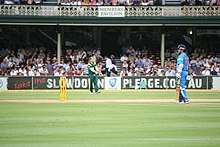Sardar Patel Stadium
| Motera Stadium | |||
| Location | Motera, Ahmedabad, Gujarat | ||
|---|---|---|---|
| Owner | Gujarat Cricket Association | ||
| Capacity |
110,000 (post-expansion, 2019 onwards)[1] 49,000(1982-2015)[2] | ||
| Surface | Grass (Oval) | ||
| Construction | |||
| Built | 1982 | ||
| Demolished | 2015 | ||
| Construction cost | ₹7,000,000,000 (reconstruction, 2017 onwards) | ||
| Architect |
Populous (reconstruction) Shashi Prabhu[3] (old site) | ||
| General contractor | Larsen & Toubro | ||
| Tenants | |||
|
Indian Cricket Team (1983–present) Gujarat cricket team (1983–present) Rajasthan Royals (2010 & 2014) Gujarat Lions (2016-present) | |||
| Ground information | |||
| Operator | Gujarat Cricket Association | ||
| End names | |||
|
Adani Pavilion End GMDC End | |||
| International information | |||
| First Test |
12 Nov – 16 Nov 1983: | ||
| Last Test |
15 Nov – 19 Nov 2012: | ||
| First ODI |
5 Oct 1984: | ||
| Last ODI |
6 November 2014: | ||
| Team information | |||
| |||
|
As of 24 Mar 2011 Source: Cricinfo | |||
Sardar Patel Gujarat Stadium (Motera Stadium) is one of the premier cricket stadiums of India in the Motera locality of Ahmedabad. Because of its location, the stadium is commonly called 'Motera Stadium' to avoid confusion with another stadium of the same name in Navrangpura, Ahmedabad. Sardar Patel stadium is owned by Gujarat Cricket Association and comes under the aegis of the West Zone. It is the largest stadium in the state of Gujarat with an official capacity of 49,000 spectators.[2][4] It is equipped with floodlights for day-and-night games and is a regular venue for Test cricket and One Day Internationals (ODI) matches. It is currently undergoing redevelopment after being demolished completely in late 2015.[5] The new stadium will be the largest cricket stadium in the world with a seating capacity of 110,000 spectators, overtaking the Melbourne Cricket Ground in Australia.[6][7][8]
Apart from cricket, the ground has played host to a number of programs arranged by the Government of Gujarat. The pitch once favoured the bowlers but has lately been host to competitive games. As of December 2011, the Motera stadium had played host to 23 ODI matches. In India, only Eden Gardens (26 ODI matches) has hosted more ODI matches than Motera Stadium.[9] The stadium was one of the host venues for 2011 Cricket World Cup held in India. It hosted three matches, including a quarter final match between India and Australia.
History
Formerly known as the Gujarat Stadium, the ground was renamed in tribute to Sardar Vallabhbhai Patel,[10] India's first Home Minister and Deputy Prime Minister. Before the Motera Stadium came into existence, international cricket matches in the city were played at Ahmedabad Municipal Corporation's stadium of the same name (Sardar Patel Stadium) in the Navrangpura area. In 1982, the government of Gujarat donated a 50-acre (200,000 m2) stretch of land on the banks of the Sabarmati River for the construction of new stadium. The construction of the Sardar Patel Stadium was carried out in a span of nine months. Since then all International cricket fixtures for the city are hosted here. Later in the 1984–85 Australia-India series, Sardar Patel Stadium hosted its first ODI, one in which Australia beat the Indians.
Sunil Gavaskar became the first-ever cricketer to score 50 runs in Test cricket on this ground — a feat he achieved against Pakistan in 1987.[11] Seven years later Kapil Dev claimed his 432nd Test wicket on this ground to become the highest wicket taker in the world, breaking Sir Richard Hadlee's record for the most number of wickets in Test matches here. Before he became the highest wicket taker, Kapil Dev made a nine-wicket haul in his career here at the Motera ground. In 1996, the ground hosted a low-scoring Test match against South Africa, where the visitors faltered while chasing a paltry 170 for a win to end up at 105 all out. Javagal Srinath scalped six wickets in the fourth innings of the match. However, South Africa had their revenge when they bowled India out for 76 runs in the first session of the Test match in 2008 and then went on to win it by an innings and 90 runs. Sachin Tendulkar became the first-ever cricketer to score 18,000 runs in One day cricket in a match against Australia during 2011 Cricket World Cup.
The stadium was one of the venues for the 2006 edition of the ICC Champions Trophy, with five of the 15 games being played here. It has hosted one game in each of the two Cricket World Cups that were played in the country, including the first match of the 1996 World Cup between England and New Zealand.
Reconstruction and Development
In October 2015, the stadium was demolished to allow for a big scale renovation. The revamped stadium has been planned to be like the Melbourne Cricket Ground.[12]
In December 2016, the construction work of the stadium was handed over to the construction company L&T [13] Also, it was confirmed that the new stadium will indeed be the largest cricket stadium in the world, with a capacity of 110,000 spectators (overtaking the Melbourne Cricket Ground, with 100,024 official capacity). It will be spread across 63 acres of land, with three entry points as opposed to just one in the old stadium. Additionally, it will contain 76 corporate boxes, an Olympic sized swimming pool, and 4 dressing rooms. On 16 January foundation stone laying was held by Gujarat Cricket Association and work started on the ground. The stadium will be ready in 2 years, and the reconstruction project is estimated to cost around ₹ 7 billion[14]
With increased area of 63 acres, the stadium will be able to accommodate several other required features, like enhanced parking for 3,000 cars and 10,000 two-wheelers, and a clubhouse with 55 rooms. The initial designs also show 3 practice grounds located adjacent to the main site. It has been hinted that the name of the stadium may change upon its completion.[15]
Records

Test match records
- Highest innings total: Sri Lanka 760/7d – India v Sri Lanka, 2nd innings, 16 Nov 2009
- Lowest innings total: India 76 – India v South Africa, 1 innings, 3 Apr 2008
- Highest individual score: Mahela Jayawardene 275 (Balls:435 4x27 6x1) – Sri Lanka v India, 16 Nov 2009
- Best bowling:
(in an innings) Kapil Dev 83/9 – India v West Indies, 12 Nov 1983
(in a match) Venkatapathy Raju 125/11 – India v Sri Lanka, 8 Feb 1994 - Most runs: Rahul Dravid (India) 771 Runs (Mat:7 Inn:14 HS:222 Ave:59.30 SR:49.10 100x3 50x1)
- Most wickets: Anil Kumble (India) 36 Wickets (Mat:7 Runs:964 BBI:7/115 BBM:10/233 Ave:26.77 Econ:2.29 SR:70.1 5W/I:3 10W/M:1)
One Day International match records
- Highest total: South Africa 365/2 – India v South Africa, 1st innings, 27 Feb 2010
- Lowest total: Zimbabwe 85 – Zimbabwe v West Indies, 1st innings, 8 Oct 2006
- Highest individual score: Sourav Ganguly 144 (Balls:152 4x8 6x6) – India v Zimbabwe, 5 Dec 2000
- Best bowling: Mitchell Johnson 4/19 (9.2 overs) – Australia v Zimbabwe, 21 Feb 2011
- Most runs: Rahul Dravid (India) 342 Runs (Mat:5 Inn:5 HS:109* Ave:114.00 SR:83.00 100x2 50x1)
- Most wickets: Kapil Dev (India) 10 Wickets (Mat:6 Runs:156 Best:3/26 Ave:15.60 Econ:3.04)
High points in cricket history
Motera has witnessed some great feats of Indian cricket history:

- Sunil Gavaskar completed 10,000 runs in Test cricket in 1986–87 against Pakistan.[16]
- Kapil Dev, who had taken 9 wickets in an innings in the first match on this ground, scalped his 432nd wicket in Test cricket to pass Sir Richard Hadlee's record, thus becoming the highest wicket taker in Test cricket at that time.[16]
- In October 1999, Sachin Tendulkar scored his first Test Match double-hundred in a match against New Zealand.
- Sachin Tendulkar completed his 20 years of International Cricket here on 16 November 2009 against Sri Lanka. During the same game, Sachin Tendulkar reached a landmark of 30,000 runs in International cricket which by far no cricketer has achieved.
- Sachin Tendulkar became the first-ever cricketer to score 18,000 runs in One day cricket in a match against Australia during 2011 Cricket World Cup.
- AB de Villiers reached his first double-hundred against India during the second test of South Africa's tour to India in 2008.
Cricket World Cup
The stadium has hosted One Day International (ODI) matches for all the Cricket World Cups whenever India has hosted the World cups namely
1987 Cricket World Cup
1996 Cricket World Cup
2011 Cricket World Cup
| v |
| v |
| v |
Gallery
- The GMDC Pavilion(before reconstruction)
- The Adani Pavilion from the 30 yard circle(before reconstruction)
- The Adani Pavilion from the GMDC end(before reconstruction)
 Iron Bull at the Stadium entrance
Iron Bull at the Stadium entrance
See also
| Wikimedia Commons has media related to Sardar Patel Stadium, Ahmedabad. |
- List of international cricket centuries at the Sardar Patel Stadium
- Dadra and Nagar Haveli Cricket Association
- Baroda Cricket Association
- Saurashtra Cricket Association
- Gujarat Lions
References
- ↑ "Revamped Motera stadium to have record one lakh seating capacity: GCA". Zee News.
- 1 2 Sardar Patel Stadium, Motera, Ahmedabad, India. ESPN Cricinfo
- ↑
- ↑ "Motera stadium back in top form". CricketNext.com.
- ↑ "Motera Stadium demolished".
- ↑ Foundation stone laid at Ahmedabad for ‘world’s largest cricket stadium’
- ↑ World's largest cricket stadium to come up in Ahmedabad | The Economic Times Video | ET Tv, retrieved 2017-01-17
- ↑ "Motera cricket stadium in Ahmedabad to become world’s biggest". http://www.hindustantimes.com/. 2017-01-17. Retrieved 2017-01-17. External link in
|newspaper=(help) - ↑ "Stadium statistics (on ESPN Cricinfo)".
- ↑ Ashwani Sharma (1 November 2014). "14 Things You Did Not Know about Sardar Patel, the Man Who United India". Topyaps. Retrieved 16 May 2014.
- ↑ "India Today article on Sunil Gavaskar's 10,000 runs".
- ↑ "Motera to have one lakh seating capacity".
- ↑ "L&T to build largest cricket stadium in the world".
- ↑ India starts building world's largest cricket stadium. Retrieved on 23rd January, 2017
- ↑ Foundation stone laid for world's largest cricket stadium
- 1 2 "Sardar Patel Stadium in Motera to be demolished". ESPNCricinfo. Retrieved 11 September 2015.
External links
- Ground profile at Cricinfo
Coordinates: 23°5′30″N 72°35′51″E / 23.09167°N 72.59750°E
